Drivers of and Barriers to Energy Renovation in Residential Buildings in Spain—The Challenge of Next Generation EU Funds for Existing Buildings
Abstract
1. Introduction
1.1. Barriers to Decisions on Energy Renovation in Buildings
1.2. Motivations for Initiating Energy-Efficient Retrofits
- -
- What are the main barriers to the adequate development of renovations despite the existence of defined actions and funds for their development?
- -
- From the energy point of view, what are the main benefits of renovations perceived by users and responsible agents that can motivate decision making in this area?
- -
- What behavior and knowledge do the agents responsible for the retrofitting process demonstrate, and are there any significant differences among them?
2. Materials and Methods
2.1. Questionnaire Design and Participants
- Category 1: Users, including owners and property administrators (professional managers of homeowners’ associations).
- Category 2: Researchers, technicians from the Public Administration or Technological Centers working in the building field.
- Category 3: Professional technicians (architects, technical architects, engineers, etc.)
- Category 4: Contractors, housing developers and material or construction system manufacturers.
- Category 5: Architecture, technical architecture and building engineering students.
- Category 6: Respondents who did not define their profile in the previous categories.
2.2. Statistical Analysis
3. Results and Discussion
3.1. Barriers to Retrofitting Existing Buildings
3.2. Benefits Driving the Retrofitting of Existing Buildings
3.3. Correlation of Barriers and Benefits to Retrofitting Existing Buildings
3.4. Strategies for Energy Retrofitting
4. Conclusions
- In terms of barriers, economic aspects, with a value of 80%, together with difficulties in obtaining subsidies (77%) and a lack of owner awareness (77%), were the most important barriers for all agents.
- We can conclude from the results analyzed separately for each group that, although economic aspects are considered important barriers, there were differences between the users and the technicians-professionals. For users, economic aspects were the main barrier (95%), followed by the scarcity of aid (88%) and the difficulty in obtaining it (86%). However, for the technicians-professionals, the main barrier was the lack of owner awareness (80%), above economic criteria (75%) and difficulties in reaching agreements in homeowners’ associations (73%). This implies that there are different perceptions within these groups, which must be taken into account to involve these agents in implementing energy renovations.
- Concerning the motivations driving energy renovations, of all those surveyed, economic savings and improving the comfort and well-being of the dwelling stood out, both with values of 87%. However, in the analysis by groups, it is surprising that, for the users, noise insulation was the most valued aspect (93%), followed by improving the comfort and well-being of the dwelling (90%), as opposed to economic savings (88%). The technicians-professionals, however, believed that economic savings (88%) are decisive in this respect, followed by improvements in comfort and well-being (82%) and noise insulation (73%).
- In both groups, the answers were dispersed due to their disparity, but surprisingly, both groups indicated reasons that do not involve the thermal properties of the building but other benefits, such as acoustic characteristics and the economic revaluation of the property. This implies a lack of knowledge about the advantages of undertaking energy improvements and that users associate comfort only with noise insulation, not thermal comfort or air quality.
- The agents were coherent in their answers when identifying important aspects to take into account in energy refurbishment, as was proved with the correlation study, but their priorities when making decisions were based not on these but on economic aspects. Moreover, the respondents acknowledged that they were more concerned about conservation and accessibility issues than energy efficiency and comfort.
- In general terms, this study shows that the bureaucratization currently entrenched in public administration is one of the main barriers to implementing energy renovation, above classic aspects such as economic ones. Without simplifying the bureaucratic process to obtain Next Generation EU funds and providing more support from the administration, the energy rehabilitation of the existing building stock will be very difficult to achieve.
- Our findings highlight agents’ lack of knowledge or lack of information regarding the actions and benefits of energy improvement. These aspects, in a few cases due to behavioral barriers and, in most cases, to different structural barriers, are the ones that hinder the decarbonization of buildings in Spain, which makes it difficult to meet the administration’s renovation goals.
- To mitigate this situation, it is necessary to carry out awareness campaigns about energy rehabilitation and to provide information on its benefits to the environment and the economic savings after its implementation, but these must be directed to the different agents involved.
Author Contributions
Funding
Data Availability Statement
Conflicts of Interest
References
- United Nations. The United Nations Framework Convention on Climate Change (UNFCCC). Available online: https://www.miteco.gob.es/es/cambio-climatico/temas/el-proceso-internacional-de-lucha-contra-el-cambio-climatico/naciones-unidas/ (accessed on 15 May 2023).
- United Nations. The Kyoto Protocol. Available online: https://www.miteco.gob.es/es/cambio-climatico/temas/el-proceso-internacional-de-lucha-contra-el-cambio-climatico/naciones-unidas/protocolo-kioto.aspx (accessed on 15 May 2023).
- United Nations. The Paris Agreement. Available online: https://www.miteco.gob.es/es/cambio-climatico/temas/el-proceso-internacional-de-lucha-contra-el-cambio-climatico/naciones-unidas/elmentos-acuerdo-paris.aspx (accessed on 15 May 2023).
- France Diplomacy. COP21: The Key Points of the Paris Agreement—Ministry for Europe and Foreign Affairs. Available online: https://www.diplomatie.gouv.fr/en/french-foreign-policy/climate-and-environment/the-fight-against-climate-change/2015-paris-climate-conference-cop21/cop21-the-paris-agreement-in-four-key-points/ (accessed on 27 February 2022).
- United Nations. Framework Convention on Climate Change. The Glasgow Climate Pact—Key Outcomes of COP26—UNFCCC. Available online: https://unfccc.int/es/process-and-meetings/the-paris-agreement/el-pacto-de-glasgow-para-el-clima-principales-resultados-de-la-cop26 (accessed on 16 May 2023).
- Zhang, S.; Zhou, N.; Feng, W.; Ma, M.; Xiang, X.; You, K. Pathway for decarbonizing residential building operations in the US and China beyond the mid-century. Appl. Energy 2023, 342, 121164. [Google Scholar] [CrossRef]
- Yan, R.; Chen, M.; Xiang, X.; Feng, W.; Ma, M. Heterogeneity or illusion? Track the carbon Kuznets curve of global residential building operations. Appl. Energy 2023, 347, 121441. [Google Scholar] [CrossRef]
- Tsemekidi-Tzeiranaki, S.; Labanca, N.; Cuniberti, B.; Toleikyte, A.; Zangheri, P.; Bertoldi, P. Analysis of the Annual Reports 2018 under the Energy Efficiency Directive-Summary Report; Publications Office of the European Union: Luxembourg, 2019. [Google Scholar]
- European Parliament and of the Council. Directive (EU) 2010/31/EU of the European Parliament and of the Council of 19 May 2010 on the Energy Performance of Buildings. 2010. Available online: https://www.boe.es/doue/2010/153/L00013-00035.pdf (accessed on 18 April 2023).
- European Parliament and of the Council. Directive (EU) 2018/844 of the European Parliament and of the Council of 30 May 2018 on energy efficiency. Off. J. Eur. Union 2018, 2018, 75–91. Available online: https://www.boe.es/buscar/doc.php?id=DOUE-L-2018-81023 (accessed on 18 April 2023).
- European Parliament and of the Council. Directive (EU) 2018/2002 of the European Parliament and of the Council of 11 December 2018 amending Directive 2012/27/EU on energy efficiency. Off. J. Eur. Union 2018, 61, L328. [Google Scholar]
- European Commission. A European Green Pact: European Commission. 2019. Available online: https://ec.europa.eu/info/strategy/priorities-2019-2024/european-green-deal_es (accessed on 16 February 2022).
- European Commission. Recovery Plan for Europe. Available online: https://commission.europa.eu/strategy-and-policy/recovery-plan-europe_en (accessed on 18 April 2023).
- European Parliament and of the Council. Regulation (EU) 2021/241 of the European Parliament and of the Council of 12 February 2021 Establishing the Resilience and Recovery Mechanism. Available online: https://www.boe.es/buscar/doc.php?id=DOUE-L-2021-80170 (accessed on 18 April 2023).
- Spanish Government. Recovery, Transformation and Resilience Plan Government of Spain. Available online: https://planderecuperacion.gob.es/ (accessed on 15 May 2023).
- Spanish Government. Rehabilitación Viviendas|Plan de Recuperación, Transformación y Resiliencia Gobierno de España. Available online: https://planderecuperacion.gob.es/politicas-y-componentes/componente-2-plan-de-rehabilitacion-de-vivienda-y-regeneracion-urbana (accessed on 18 April 2023).
- Ministerio para la Transición Ecológica y el Reto Demográfico. Plan Nacional Integrado de Energía y Clima (PNIEC) 2021–2030; Ministerio para la Transición Ecológica y el Reto Demográfico: Madrid, Spain, 2020; pp. 1–427. Available online: https://www.idae.es/informacion-y-publicaciones/plan-nacional-integrado-de-energia-y-clima-pniec-2021-2030 (accessed on 18 April 2023).
- De Santiago, E. Segmentation of the Residential Housing Stock in SPAIN into Typological Clusters. Study (01) for the ERESEE 2020; Ministerio de Fomento: Madrid, Spain, 2020; no. 1; pp. 1–87. Available online: https://cdn.mitma.gob.es/portal-web-drupal/planes_estartegicos/1_2020_segmentacion_parque_residencial_clusteres.pdf (accessed on 18 April 2023).
- Arcas-Abella, J.; Pagès-Ramon, A.; Gutiérrez Romero, G.; Bilbao Figuero, A. Approximation to Residential Energy Demand for Heating in SPAIN. Study (02) for the ERESEE 2020, Long-Term Strategy for Energy Renovation in the Building Sector in Spain. 2018. Available online: https://cdn.mitma.gob.es/portal-web-drupal/planes_estartegicos/2_2020_aproximacion_demanda_residencial.pdf (accessed on 18 April 2023).
- Fernandes, M.S.; Rodrigues, E.; Gaspar, A.R.; Costa, J.J.; Gomes, Á. The contribution of ventilation on the energy performance of small residential buildings in the Mediterranean region. Energy 2020, 191, 116577. [Google Scholar] [CrossRef]
- Pinazo, J.; García, R.; Vicente, P.; García, A. Report on the Outlook and Future Evolution of Air-Conditioning and DHW Systems in Residential Buildings. Study (04) for the ERESEE 2020; Ministerio de Fomento: Madrid, Spain, 2020. Available online: https://cdn.mitma.gob.es/portal-web-drupal/planes_estartegicos/4_2020_sistemas_climatizacion_y_acs_residencial.pdf (accessed on 18 April 2023).
- Alonso, A.; Calama-González, C.M.; Suárez, R.; León-Rodríguez, L.; Hernández-Valencia, M. Improving comfort conditions as an energy upgrade tool for housing stock: Analysis of a house prototype. Energy Sustain. Dev. 2022, 66, 209–221. [Google Scholar] [CrossRef]
- Szymańska, E.J.; Kubacka, M.; Woźniak, J.; Polaszczyk, J. Analysis of Residential Buildings in Poland for Potential Energy Renovation toward Zero-Emission Construction. Energies 2022, 15, 9327. [Google Scholar] [CrossRef]
- Spanish Government. Royal Decree 732/2019, of 20 December, Amending the Technical Building Code, Approved by Royal Decree 314/2006, of 17 March. BOE-A-2019-18528. Available online: https://www.boe.es/diario_boe/txt.php?id=BOE-A-2019-18528 (accessed on 15 May 2023).
- IDAE (Institute for Energy Diversification and Saving). Residential Final Energy Consumption (2010–2018). 2020. Available online: https://www.idae.es/sites/default/files/estudios_informes_y_estadisticas/cons_usos_resid_eurostat_web_2010-18_ok (accessed on 18 April 2023).
- Arto, I.; González-Eguino, M.; Rodríguez-Zúñiga, A.; Tomás, M. Economic Impact of Energy Renovation of Dwellings in Spain in the Period 2021–2030. Study (07) for the ERESEE 2020; Ministerio de Fomento: Madrid, Spain, 2021; no. 7. Available online: https://cdn.mitma.gob.es/portal-web-drupal/planes_estartegicos/7_2020_impacto_macroeconomico_rehabilitacion.pdf (accessed on 18 April 2023).
- Mortensen, A.; Heiselberg, P.; Knudstrup, M. Economy controls energy retrofits of Danish single-family houses. Comfort, indoor environment and architecture increase the budget. Energy Build. 2014, 72, 465–475. [Google Scholar] [CrossRef]
- Tuominen, P.; Klobut, K.; Tolman, A.; Adjei, A.; de Best-Waldhober, M. Energy savings potential in buildings and overcoming market barriers in member states of the European Union. Energy Build. 2012, 51, 48–55. [Google Scholar] [CrossRef]
- O’Malley, E.; Scott, S.; Sorrell, S. Barriers to Energy Efficiency: Evidence from Selected Sectors. Research Series. 2003. Available online: https://ideas.repec.org/b/esr/resser/prs47.html (accessed on 20 April 2023).
- Azimi, S.; Hon, C.K.H.; Tyvimaa, T.; Skitmore, M. Barriers to Energy Efficiency: Low-Income Households in Australia. Buildings 2023, 13, 954. [Google Scholar] [CrossRef]
- Szymańska, E.J.; Kubacka, M.; Polaszczyk, J. Households’ Energy Transformation in the Face of the Energy Crisis. Energies 2023, 16, 466. [Google Scholar] [CrossRef]
- Hirst, E.; Brown, M. Closing the efficiency gap: Barriers to the efficient use of energy. Resour. Conserv. Recycl. 1990, 3, 267–281. [Google Scholar] [CrossRef]
- Heutel, G. Prospect theory and energy efficiency. J. Environ. Econ. Manag. 2019, 96, 236–254. [Google Scholar] [CrossRef]
- Wilson, C.; Crane, L.; Chryssochoidis, G. Why do homeowners renovate energy efficiently? Contrasting perspectives and implications for policy. Energy Res. Soc. Sci. 2015, 7, 12–22. [Google Scholar] [CrossRef]
- Murphy, L. The influence of energy audits on the energy efficiency investments of private owner-occupied households in the Netherlands. Energy Policy 2014, 65, 398–407. [Google Scholar] [CrossRef]
- Cooremans, C.; Schönenberger, A. Energy management: A key driver of energy-efficiency investment? J. Clean. Prod. 2019, 230, 264–275. [Google Scholar] [CrossRef]
- Vogel, J.A.; Lundqvist, P.; Arias, J. Categorizing Barriers to Energy Efficiency in Buildings. Energy Procedia 2015, 75, 2839–2845. [Google Scholar] [CrossRef]
- SStern, P.C. Individual and household interactions with energy systems: Toward integrated understanding. Energy Res. Soc. Sci. 2014, 1, 41–48. [Google Scholar] [CrossRef]
- Ameli, N.; Brandt, N. Determinants of households’ investment in energy efficiency and renewables: Evidence from the OECD survey on household environmental behaviour and attitudes. Environ. Res. Lett. 2015, 10, 44015. [Google Scholar] [CrossRef]
- Azizi, S.; Nair, G.; Olofsson, T. Analysing the house-owners’ perceptions on benefits and barriers of energy renovation in Swedish single-family houses. Energy Build. 2019, 198, 187–196. [Google Scholar] [CrossRef]
- Gynther, L.; Mikkonen, I.; Smits, A. Evaluation of European energy behavioural change programmes. Energy Effic. 2012, 5, 67–82. [Google Scholar] [CrossRef]
- Domínguez, S.; Sendra, J.J.; León, A.L.; Esquivias, P.M. Towards Energy Demand Reduction in Social Housing Buildings: Envelope System Optimization Strategies. Energies 2012, 5, 2263–2287. [Google Scholar] [CrossRef]
- Zundel, S.; Stieß, I. Beyond Profitability of Energy-Saving Measures—Attitudes Towards Energy Saving. J. Consum. Policy 2011, 34, 91–105. [Google Scholar] [CrossRef]
- Organ, S.; Proverbs, D.; Squires, G. Motivations for energy efficiency renovation in owner-occupied housing. Struct. Surv. 2013, 31, 101–120. [Google Scholar] [CrossRef]
- European Commission. How Does Level(s) Work? Available online: https://environment.ec.europa.eu/topics/circular-economy/levels/lets-meet-levels/how-does-levels-work_en (accessed on 20 April 2023).
- Achtnicht, M.; Madlener, R. Factors influencing German house owners’ preferences on energy retrofits. Energy Policy 2014, 68, 254–263. [Google Scholar] [CrossRef]
- Bryer, J.; Speerschneider, K. Likert: Analysis and Visualization Likert Items. R Package Version 1.3.5. 2016. Available online: https://CRAN.R-project.org/package=likert (accessed on 7 July 2023).
- Wei, T.; Simko, V. R Package ‘Corrplot’: Visualization of a Correlation Matrix (Version 0.92). 2021. Available online: https://github.com/taiyun/corrplot (accessed on 7 July 2023).
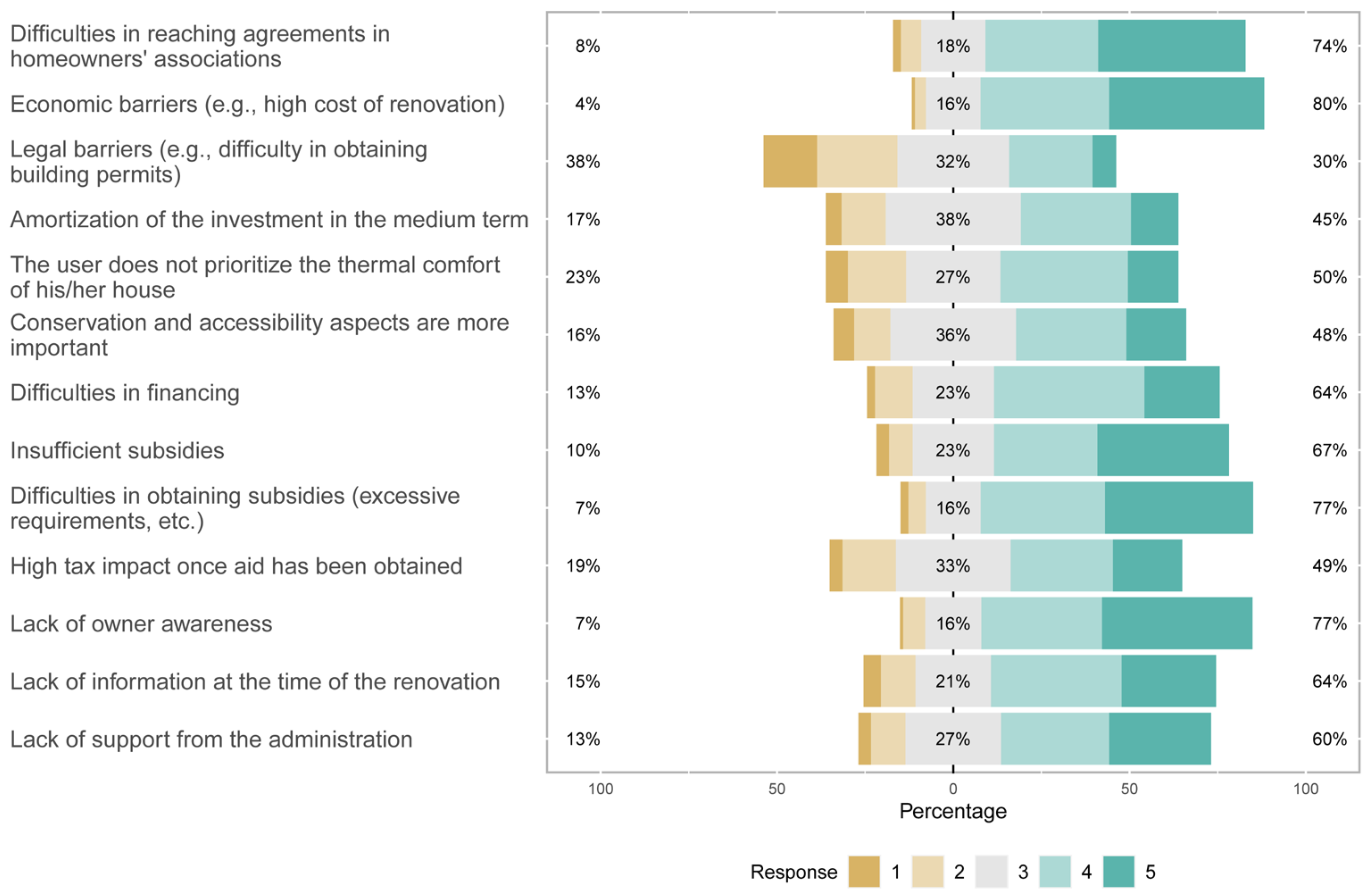
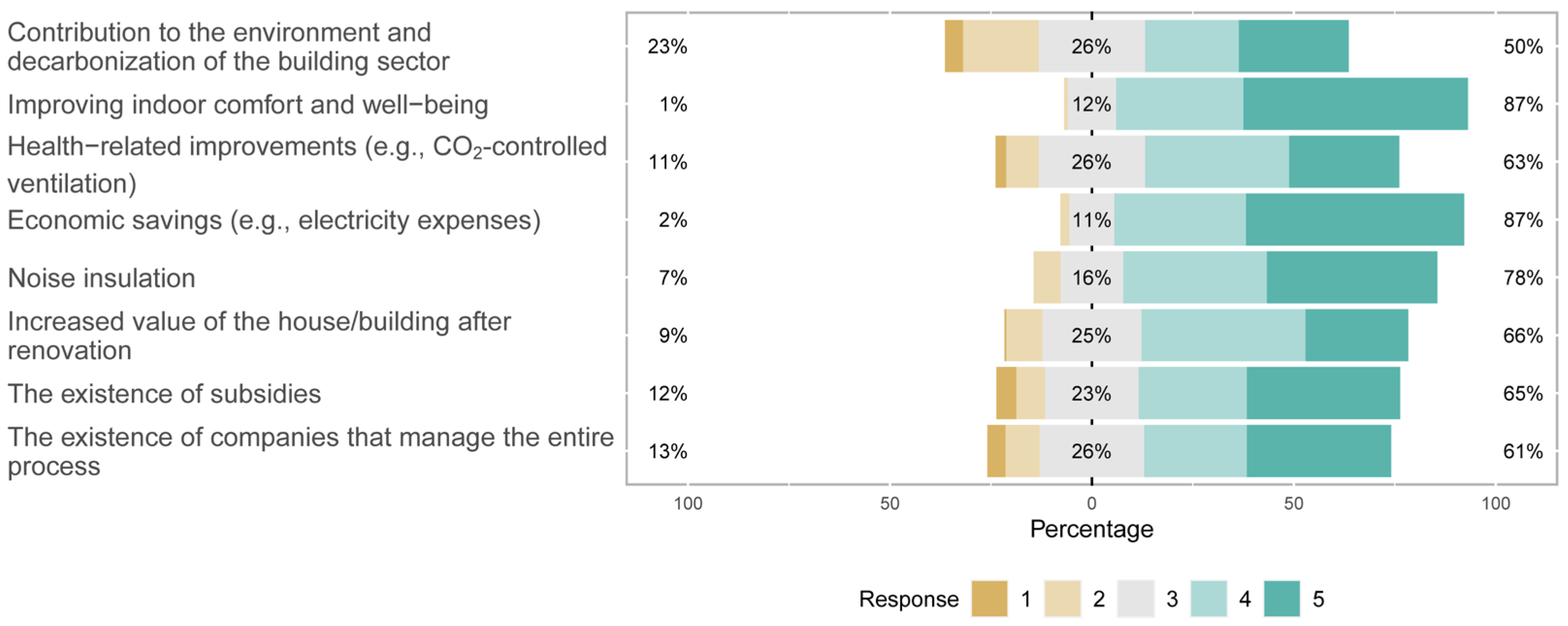


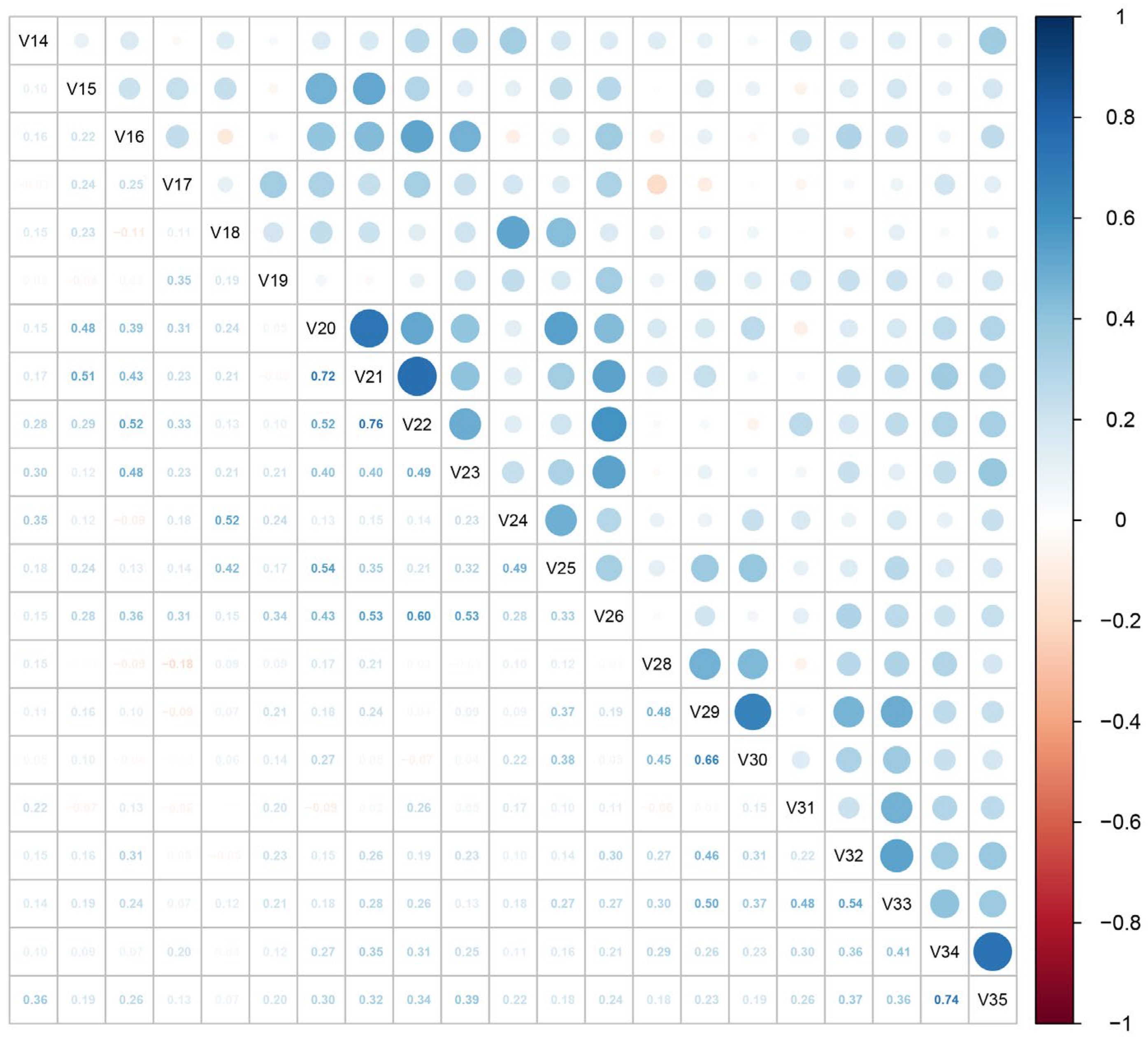
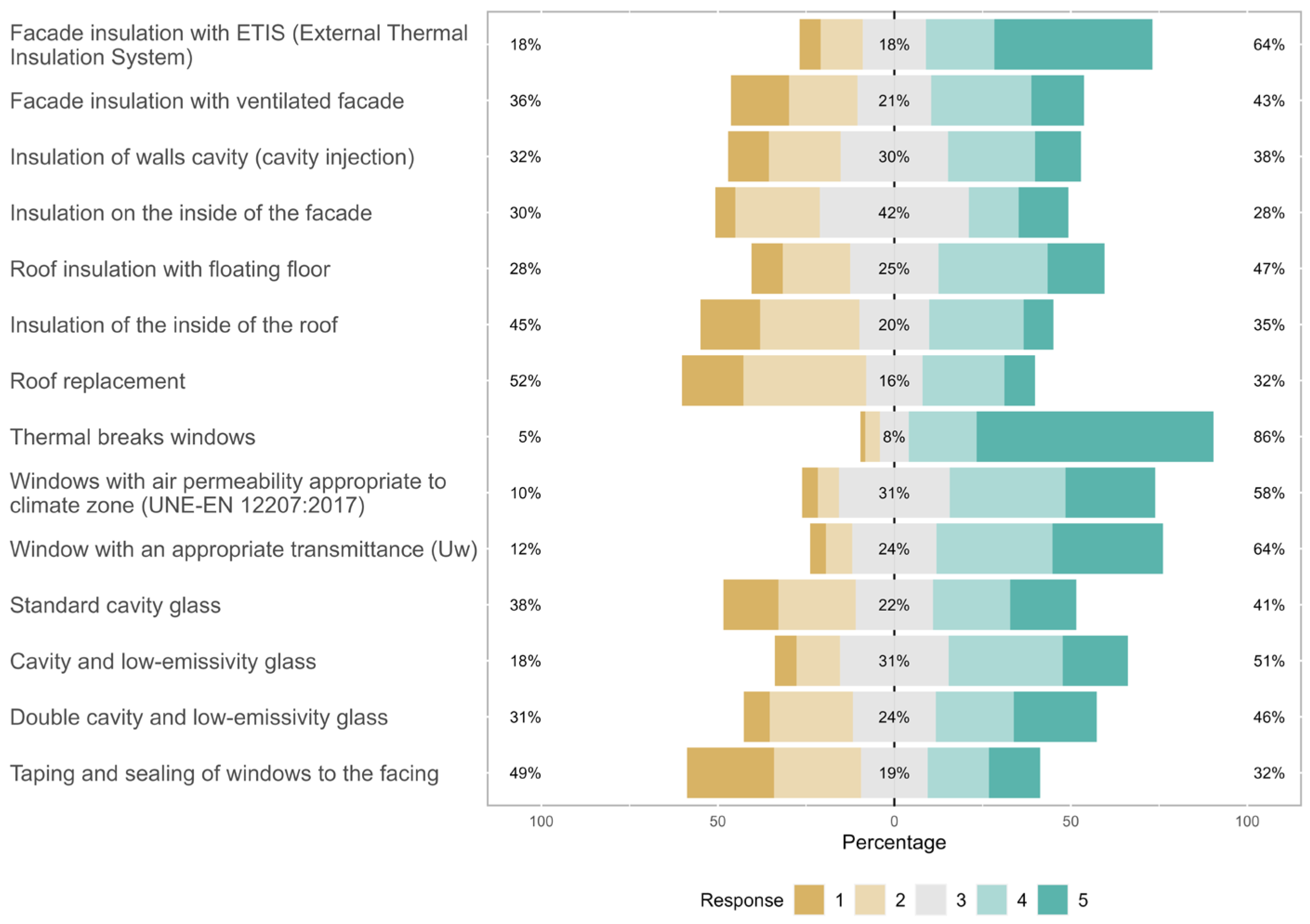
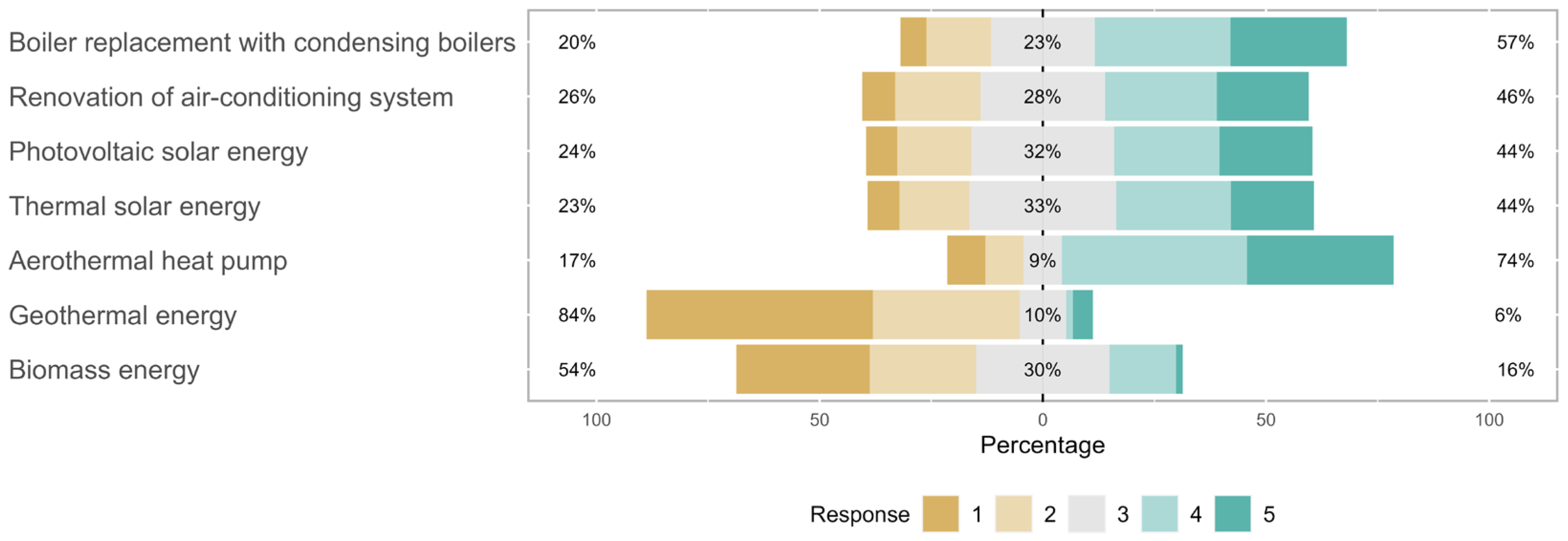
| Respondent Profile | Category | Answers | % |
|---|---|---|---|
| Users | 1 | 42 | 14.2% |
| Public administration | 2 | 29 | 9.8% |
| Technology centers | 2 | 24 | 8.1% |
| Professional technicians | 3 | 89 | 30.1% |
| Manufacturing companies | 4 | 14 | 4.7% |
| Construction companies | 4 | 7 | 2.4% |
| Students arch./building eng. | 5 | 2 | 0.7% |
| Financial sector | 5 | 2 | 0.7% |
| Other | 6 | 18 | 6.1% |
| Do not know/Do not answer (Dk/Da) | -- | 69 | 23.3% |
| Total | 296 |
| In Your Opinion, What Are the Barriers That Prevent More Energy Renovations of Houses/Buildings from Being Carried Out? | |
|---|---|
| V14 | Difficulties in reaching agreements in homeowners’ associations |
| V15 | Economic barriers (e.g., high cost of renovation) 1 |
| V16 | Legal barriers (e.g., difficulty in obtaining building permits) |
| V17 | Amortization of the investment in the medium term 1 |
| V18 | The user does not prioritize the thermal comfort of his/her house |
| V19 | Conservation and accessibility aspects are more important 1 |
| V20 | Difficulties in financing |
| V21 | Insufficient subsidies 1 |
| V22 | Difficulties in obtaining subsidies (excessive requirements, etc.) 1 |
| V23 | High tax impact once aid has been obtained 1 |
| V24 | Lack of owner awareness |
| V25 | Lack of information at the time of the renovation |
| V26 | Lack of support from the administration |
| Barriers | % Score 1 and 2 | % Score 3 | % Score 4 and 5 | |||
|---|---|---|---|---|---|---|
| Users | Technicians-Professionals | Users | Technicians-Professionals | Users | Technicians-Professionals | |
| Difficulties in reaching agreements in homeowners’ associations | 0% | 10% | 20% | 30% | 40% | 50% |
| Economic barriers (e.g., high economic cost of renovation) | 60% | 70% | 80% | 90% | 100% | 75% |
| Legal barriers (e.g., difficulty in obtaining building permits) | 45% | 43% | 21% | 34% | 33% | 24% |
| Amortization of the investment in the medium term | 10% | 16% | 31% | 53% | 60% | 31% |
| The user does not prioritize the thermal comfort of his/her house | 17% | 19% | 24% | 28% | 60% | 53% |
| Conservation and accessibility aspects are more important | 10% | 21% | 17% | 40% | 74% | 38% |
| Difficulties in financing | 12% | 17% | 19% | 30% | 69% | 53% |
| Insufficient subsidies | 5% | 11% | 7% | 28% | 88% | 61% |
| Difficulties in obtaining subsidies (e.g., excessive requirements) | 2% | 9% | 12% | 19% | 86% | 72% |
| High tax impact once aid has been obtained | 17% | 25% | 26% | 29% | 57% | 46% |
| Lack of awareness of owners | 5% | 2% | 17% | 18% | 79% | 80% |
| Lack of information at the time of renovation | 19% | 15% | 29% | 19% | 52% | 66% |
| Lack of support from the administration | 5% | 18% | 24% | 29% | 71% | 53% |
| In Your Opinion, What Are the Key Aspects That Can Motivate Energy Renovation in Houses/Buildings? | |
|---|---|
| V28 | Contribution to the environment and decarbonization of the building sector |
| V29 | Improving indoor comfort and well-being |
| V30 | Health-related improvements (e.g., CO2-controlled ventilation) |
| V31 | Economic savings (e.g., electricity expenses) |
| V32 | Noise insulation 1 |
| V33 | Increased value of the house/building after renovation 1 |
| V34 | The existence of subsidies |
| V35 | The existence of companies that manage the entire process |
| Motivations | % Score 1 and 2 | % Score 3 | % Score 4 and 5 | |||
|---|---|---|---|---|---|---|
| Users | Technicians-Professionals | Users | Technicians-Professionals | Users | Technicians-Professionals | |
| Contribution to the environment and decarbonization of the building sector | 19% | 31% | 24% | 19% | 57% | 49% |
| Improving indoor comfort and well-being | 2% | 1% | 7% | 17% | 90% | 82% |
| Health-related improvements (e.g., CO2-controlled ventilation) | 14% | 11% | 29% | 34% | 57% | 55% |
| Economic savings (e.g., electricity expenses) | 0% | 1% | 12% | 11% | 88% | 88% |
| Noise insulation | 5% | 7% | 2% | 20% | 93% | 73% |
| Increased value of the house/building after renovation | 10% | 10% | 10% | 28% | 81% | 62% |
| The existence of subsidies | 19% | 10% | 17% | 21% | 64% | 69% |
| The existence of companies that manage the entire process | 19% | 12% | 31% | 28% | 50% | 60% |
Disclaimer/Publisher’s Note: The statements, opinions and data contained in all publications are solely those of the individual author(s) and contributor(s) and not of MDPI and/or the editor(s). MDPI and/or the editor(s) disclaim responsibility for any injury to people or property resulting from any ideas, methods, instructions or products referred to in the content. |
© 2023 by the authors. Licensee MDPI, Basel, Switzerland. This article is an open access article distributed under the terms and conditions of the Creative Commons Attribution (CC BY) license (https://creativecommons.org/licenses/by/4.0/).
Share and Cite
Pérez-Navarro, J.; Bueso, M.C.; Vázquez, G. Drivers of and Barriers to Energy Renovation in Residential Buildings in Spain—The Challenge of Next Generation EU Funds for Existing Buildings. Buildings 2023, 13, 1817. https://doi.org/10.3390/buildings13071817
Pérez-Navarro J, Bueso MC, Vázquez G. Drivers of and Barriers to Energy Renovation in Residential Buildings in Spain—The Challenge of Next Generation EU Funds for Existing Buildings. Buildings. 2023; 13(7):1817. https://doi.org/10.3390/buildings13071817
Chicago/Turabian StylePérez-Navarro, Julián, María Carmen Bueso, and Gemma Vázquez. 2023. "Drivers of and Barriers to Energy Renovation in Residential Buildings in Spain—The Challenge of Next Generation EU Funds for Existing Buildings" Buildings 13, no. 7: 1817. https://doi.org/10.3390/buildings13071817
APA StylePérez-Navarro, J., Bueso, M. C., & Vázquez, G. (2023). Drivers of and Barriers to Energy Renovation in Residential Buildings in Spain—The Challenge of Next Generation EU Funds for Existing Buildings. Buildings, 13(7), 1817. https://doi.org/10.3390/buildings13071817








